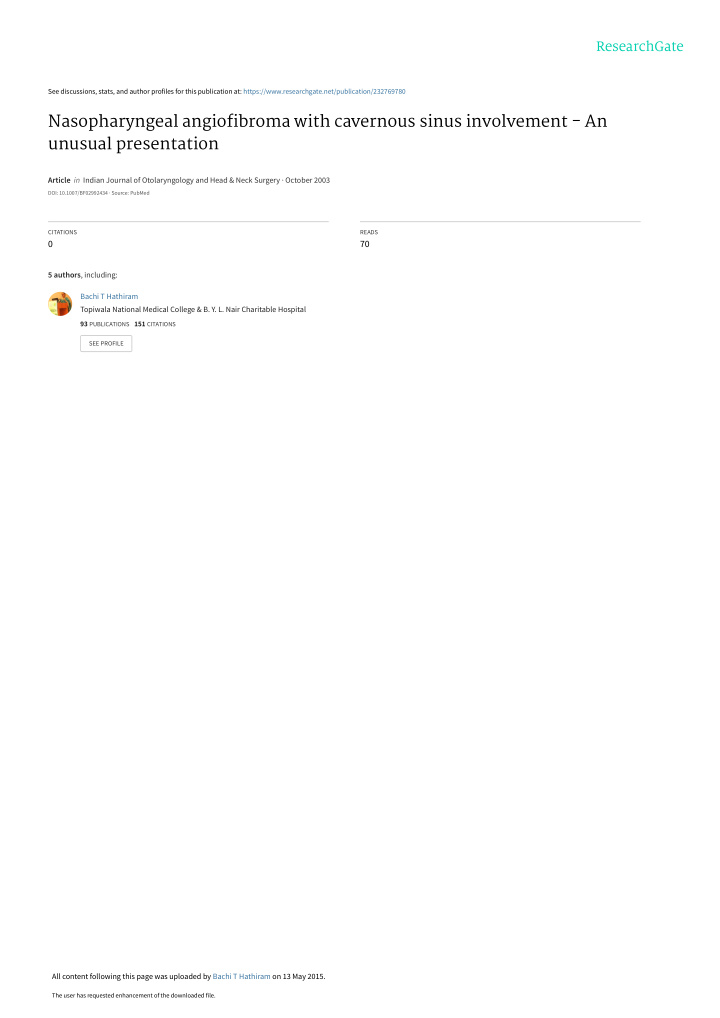



See discussions, stats, and author profiles for this publication at: https://www.researchgate.net/publication/232769780 Nasopharyngeal angiofibroma with cavernous sinus involvement - An unusual presentation Article in Indian Journal of Otolaryngology and Head & Neck Surgery · October 2003 DOI: 10.1007/BF02992434 · Source: PubMed CITATIONS READS 0 70 5 authors , including: Bachi T Hathiram Topiwala National Medical College & B. Y. L. Nair Charitable Hospital 93 PUBLICATIONS 151 CITATIONS SEE PROFILE All content following this page was uploaded by Bachi T Hathiram on 13 May 2015. The user has requested enhancement of the downloaded file.
NASOPHARYNGEALANGIOFIBROMA WITH CAVERNOUS SINUS INVOLVEMENT - AN UNUSUAL PRESENTATION Dinaz Namdarian z, N. L. Hiranandani 2, Bachi Hathiram 3, Rajeevan C. p.4, Ritu Agarwal 5 INTRODUCTION epistaxis and a nasal twang since a period of 1 year. The Juvenile nasopharyngeal angiofibroma (JNA) is an patient was alright 1 year back when he started uncommon benign vascular tumor occurring almost experiencing a right sided nasal obstruction which was exclusively in pre-pubescent or pubescent males. The triad gradually increasing. He also complained of repeated of epistaxis, nasal obstruction and the presence of a episdes of epistaxis, which increased to 10-15 cc of fresh nasopharyngeal mass strongly indicates an angio-fibroma, blood daily. The epistasis was controlled by the patient by especially when seen in an adolescent male. It accounts lying in the supine position. There was no headache, for less than 0.05% of head and neck tumors (Waldman et al, 1981). Its incidence has been stated to be as low as one in 50,000 otolaryngological new patients (Chandler et al, 1984). Intracranial extension has been observed in 20- 30% patients with JNA (Jafek et al, 1979; Cummings et al 1984). It is a benign tumor and is locally aggessive eroding adjacent bone and growing through natural foramina and fissures thus gaining an easy access into the cranium and the infratemporal region. The intracranial extension is either through erosion of the sphenoid sinus through the sella medial to the carotid artery and lateral to the pituitary gland or via erosion of the greater wing of sphenoid through the middle cranial fossa anterior to the foramen Fig. l : X-Ray lateral view of nasoppharynx showing a hugh mass in the nose, nasopharynx and oropharynx. lacerum and lateral to the cavernous sinus and carotid artery. In this paper we report our experience of an unusual presentation of a huge JNA with intracranial extension into the middle cranial fossa, which encroached the cavernous sinus. We treated it surgically by the conventional combined lateral rhinotomy and transpalatal approaches. The entire tumor including the intracranial extent was removed without opening the cranium. CASE REPORT Fig. II : (A) Contrast CT scan axial view showing a large well defined A l 7 year old boy was referred to us with chief complaints moderately enhancing mass involving the right nasal cavity of right sided nasal obstruction, repeated episodes of nasopharynx pterygopalatine fossa and infratemporal fossa. ~Lecturer, :Honorary Professor, 3Lecturer, 4Senior Resisdent, 5Senior Resident, Department of Otorhinolaryngology, T. N. Medical College and B. Y. L. Nair Charitable Hospital, Mumbai 400 008, India.
266 Nasopharyngeal Angiofibroma with Cavernous Sinus Invoh,ement - An Unusual Presentation Fig. I1 (B) Contrast CT scan coronal view showing a large well defined Fig. III : Gross appearance of the specimen. moderately enhancing mass involving the nasopharynx, infratemporal fossa and extending into the sphenoid sinus and middle cranial.fossa. Fig. IV : Microphotograph showing features of angiofibroma ( H & E) x 400. Fig: II (C) A contrast CT scan coronal view showing the enhancing mass involving the right cavernous sinus. X-ray nasopharynx revealed a mass occupying the entire nasal cavity, nasopharynx and upper part of the oropharynx vomiting, diplopia or any other symptoms suggestive of (Fig. 1). raised intracranial tension or involvement of the cavernous sinus. The patient occasionally complained of bleeding The contrast CT scan axial and coronal views revealed a from the mouth. large well defined moderately enhancing nasopharyngeal mass extending into the right nasal cavity with widening On general examination, the patient was anaemic. There of the pterygopalatine fossa on the right side. It was was widening of the bridge of the nose. Anterior extending into the intratemporal fossa laterally, into the rhinoscopy showed purulent discharge in the right nasal sphenoid sinus, right optic canal and middle cranial fossa cavity and a huge reddish lobulated mass seen extending encroaching on the posterior and medial aspect of the into the oropharynx behind the palate for about 2 cm. right cavernous sinus superiorly and into the oropharynx inferiorly (Fig. II, A. B, C.). Hematological investigations of the patient were as follows Haemoglobin = 6 gm%, PCV = 42 GM%, MVC = 65 ft., The diagnosis of JNA with intracranial extension MCH = 25 pg. ; MCHC = 25%, BUN = 15 mg%, Serum (cavernous sinus) was made and the patient was advised creatinine 0.5 mg%, Serum Na 133 mEq/L, Serum K 3.5 surgery - combined lateral rhinotomy with transpalatal mEq/L, ESR = 9 mm at the end of the Serum Ca = 9 approach. Pre-operatively, 5 units of blood were transfused mg%. to the patient to bring the haemoglobin to 11 gm%. General anaesthesia was given. The right external carotid artery On radiographic investigations the X-ray chest was was ligated. A lateral rhinotomy and transpalatal incisions normal. The X-ray paranasal sinuses Water's and were taken. The lateral rhinotomy incision was extended Caldwell's view showed haziness in the right nasal cavity sublabially. The flaps were elevated and the maxillary and right maxillary sinus without bony destruction. The antrum was opened and inspected. The medial wall of the Indian Journal of Otolaryngology and Head and Neck Surgetlv Vol. 55 No. 4. October - December 2003
Recommend
More recommend